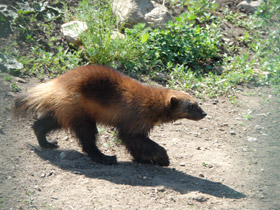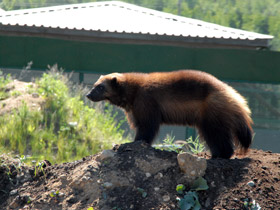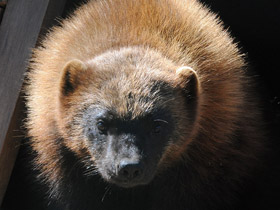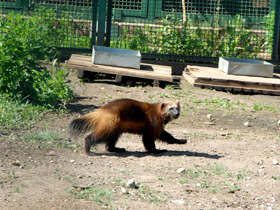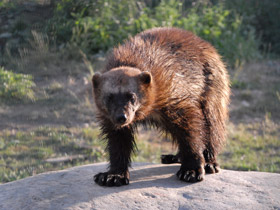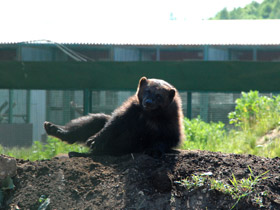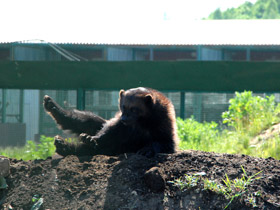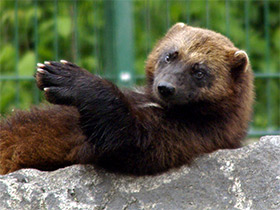The wolverine, the glutton, carcajou, or quickhatch (Gulo gulo)
The wolverine (/ˈwʊlvəriːn/) (Gulo gulo; Gulo is Latin for "glutton"), also referred to as the glutton, carcajou, or quickhatch (from East Cree, kwiihkwahaacheew), is the largest land-dwelling species of the family Mustelidae. It is a muscular carnivore and a solitary animal. The wolverine has a reputation for ferocity and strength out of proportion to its size, with the documented ability to kill prey many times larger than itself.
Taxonomy
Genetic evidence suggests that the wolverine is most closely related to the tayra and martens, all of which shared a Eurasian ancestor.
There are two subspecies: the Old World form, Gulo gulo gulo, and the New World form, Gulo gulo luscus. Some authors had described as many as four additional North American subspecies, including ones limited to Vancouver Island (Gulo gulo vancouverensis) and the Kenai Peninsula in Alaska (Gulo gulo katschemakensis). However, the most currently accepted taxonomy recognizes either the two continental subspecies or Gulo gulo as a single Holarctic taxon.
Recently compiled genetic evidence suggests most of North America's wolverines are descended from a single source, likely originating from Beringia during the last glaciation and rapidly expanding thereafter, though considerable uncertainty to this conclusion is due to the difficulty of collecting samples in the extremely depleted southern extent of the range.
Appearance
The Gulo gulo is a large animal (body length 76-90 cm, weight 9-18 kg), very different from other representatives of the family, distinguished by its flexibility and grace. The appearance of the wolverine is similar to that of a bear or a badger: its body is stocky and clumsy; the legs are short; the head is large and elongated; the tail is short but very fluffy (photos 1, 2, 3). The feet of Gulo gulo are disproportionately large (10 cm wide and 9 cm long) (photo 4), a device for hunting in deep, loose snow. With powerful legs, long claws and a tail that acts as a balancer, the Gulo gulo can easily climb trees.
Lifestyle and nutrition
The Gulo gulo is a strong and cautious animal, but very feisty. The Saami, who live on the Kola peninsula, call the Gulo gulo a forest demon. Despite its relatively small size, it is not afraid to face a bear, and a lone wolf does not even try to fight it, preferring to leave its prey to it. Because of its slowness, the Gulo gulo prefers not to hunt, but to scavenge carrion and scraps, or capture prey from other predators. Its keen sense of smell allows it to sniff out carrion many kilometres away or under a thick layer of snow. Unlike most sedentary rodents, the Gulo gulo constantly migrates in search of prey throughout its individual range, which covers up to 1500-2000 km².
It feeds mainly on ungulate young, rodents, hares, birds and even insect larvae, and sometimes catches fish during the winter, remaining stationed near ice pits for long periods. This predator also feeds on plants, mushrooms, berries, young shoots and juicy roots. The Gulo gulo spends most of its life on land and often gallops (photo 5). It is also an excellent swimmer (photo 6) and has remarkable endurance.
Reproduction
The Gulo gulo only makes a den when it is about to breed, which occurs every two to three years. The Gulo gulo's pregnancy lasts a long time, up to 9 months, after which they give birth to 2 or 3 young, which only regain their sight during the fifth week of life. The young remain in their mother's care until the following summer and sometimes longer.


















